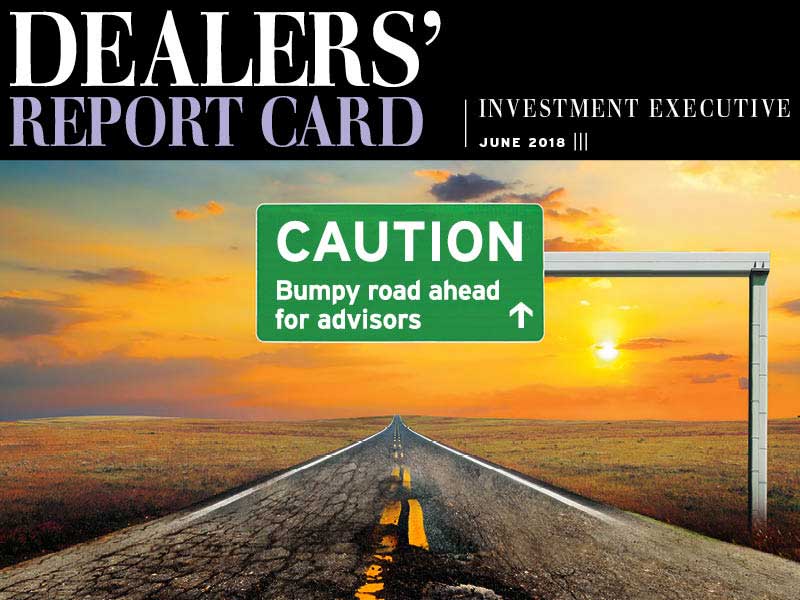
The full implementation of the second phase of the client relationship model (CRM2) has resulted in changes to clients’ account statements to reflect the necessary enhanced portfolio performance information and cost disclosure mandated by the CRM2 regulatory regime. Yet, these changes have resulted in an increased level of difficulty for clients when reading their statements.
But clients are not the only people who are having issues with the revised account statements. In fact, five dealer firms were rated lower by half a point or more vs last year in the “client account statements” category by their financial advisors who were surveyed for this year’s Dealers’ Report Card. These lower ratings are due not only to the abundance of information that has to be presented in the account statements, but also to the lack of consolidated information from a client’s multiple statements – information that isn’t available anymore – which has led to a surge in client complaints.
These factors have led advisors with Toronto-based HollisWealth Inc. to rate their firm at 5.3 in this category. Not only is that rating down significantly from 6.7 in last year’s Report Card (which, in turn, dropped from 7.3 in 2016), but this year’s rating also is the lowest rating in the category among all firms ranked in the Report Card.
HollisWealth’s advisors noted that the amount of information now displayed on their clients’ statements because the CRM2 mandate makes the data far more difficult for their clients to understand.
“I get a lot of clients saying, ‘I don’t understand my new statements’,” says a HollisWealth advisor in British Columbia. “The statements, before, were crystal clear and these are murky.”
Adds a colleague in Ontario: “The regulators are shoving [the information] down [clients’] throats. All clients want to know is how much [they had in their accounts] last month and how much [they] have today. Clients are turning [their statements] upside down and sideways and holding them up to the light to try to understand them.”
HollisWealth’s advisors also complained that their clients’ statements aren’t consolidated by households anymore, which had been more effective for clients to read.
“We used to combine the statements. Now, we have separate statements: one for the husband, one for the wife and one for a joint account,” says a HollisWealth advisor in Ontario. “The combined statements have to be 100% right because you have to spend a bunch of time explaining [to clients] why the numbers don’t match up.”
Advisors with Oakville, Ont.-based Manulife Securities, Calgary-based Portfolio Strategies Corp. and Winnipeg-based Investors Group Inc. also rated their firms’ client account statements lower by half a point or more, echoing other advisors’ frustrations about the lack of clarity and consolidation on the statements.
“They just have to be easier to read,” says an Investors Group advisor in Ontario. “I get clients telling me they can’t make heads or tails out of [their statements].”
Both Todd Asman, executive vice president of products and financial planning with Investors Group in Winnipeg, and Mike Dibden, chief operating officer of Toronto-based IGM Financial Inc. (Investors Group’s parent), point out that the information displayed on client account statements is out of the firm’s control due to regulatory requirements. However, both executives hope that the implementation of a new online portal that’s expected to be rolled out this year will help clients understand their investment information better and resolve the issues advisors and clients have been experiencing.
“Statements are a regulatory document,” Asman says. “I think that moving toward a portal or an app that delivers the view into the client’s experience [means] you have a much richer way of being able to present things. And I don’t think statements are going to be the primary way that people access their [financial] information.”
Shabeen Hanifa, manager, external communications, with Toronto-based Manulife Financial Corp. (parent of Oakville, Ont.-based Manulife Securities), also points out that CRM2’s requirements may have caused advisors and their clients to be dissatisfied with the account statements.
“[Statements] are regulated for each account, so you need to have separate account statements,” says Hanifa. “So, if a client has a TFSA and an RRSP, there’s about four to six pages [for each account].”
Manulife Securities is focusing on how to make account statements easier for clients to read, she adds: “One of the things that Manulife is focusing on is updating to language that’s user-friendly. Coming up, the language you’re going to see is a lot more customer-friendly, and we’re trying to make it easier [for clients].”
In the case of Markham, Ont.-based Worldsource Wealth Management Inc., the combination of the CRM2-mandated requirements and issues related to the changes to the firm’s technology platforms contributed to that firm’s advisors giving Worldsource a rating of 6.0 in the category. That was the second-lowest rating for the category, which dropped from 7.0 in 2017.
“When [Worldsource made the] change to Dataphile from Univeris [earlier this year, that] switched everybody back to paper statements,” says a Worldsource advisor in Ontario. “Especially with CRM2, we got people used to seeing everything [online] – and then, to have that gone, [it’s as if] we just punched them in the stomach.”